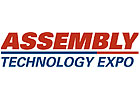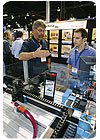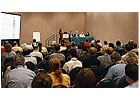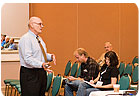
Spending may be down, but assemblers in the United States will still invest more than $2.5 billion in new assembly equipment this year, according to ASSEMBLY magazine’s 13th annual capital equipment spending survey.
Not only that, as the economy in general and manufacturing in particular pick up again, assemblers will have to work smarter and better than ever before if they are to survive. The new economy promises to be an increasingly global one, and that means increased competition. Along these same lines, the technologies driving the new economy-things like solar cells, personal electronics, medical devices and fuel-efficient vehicles-are going to demand higher quality processes than ever.
Both of these trends will require the best in capital equipment, including everything from fully automated systems to precision tools, conveyors and process monitoring software. And it’s all going to be on display at this year’s Assembly Technology Expo (ATExpo), set to take place at the Donald E. Stephens Convention Center, adjacent to Chicago’s O’Hare Airport, Sept. 22-24.

As in years past, ATExpo
2009 will bring together hundreds of different exhibitors displaying the latest
in assembly equipment and technology.
Everything You Need
As in years past, ATExpo will be co-located with a number of other shows, including Medical Design & Manufacturing Midwest (MD&M Midwest), the Green Manufacturing Expo, Quality Expo and two new events, Design & Manufacturing Midwest and the Electronics Midwest Show.This year’s Design & Manufacturing Midwest show will include exhibitors featuring the latest in CAD, CAM and CAE software, computer hardware and peripherals, contract manufacturing services, linear motion devices, material handling systems, plant engineering products, motors, drives and other manufacturing support equipment.
Similarly, Electronics Midwest will be your one-stop source for the latest in component insertion and placement equipment, soldering machines and everything else you’ll need to manufacture and package printed circuit boards.
Quality Expo, on the other hand, will provide hands-on access to the newest tools and broadest array of technologies to help you ensure quality, reduce costs, streamline your process and deliver the value your customers expect.
For those either already a part of, or planning to become a part of the red-hot medical-device industry, MD&M Midwest will bring together many of the major equipment, materials and service providers doing business in the Midwest and beyond.
Finally, for those looking to either become a part of the new green economy or cut their costs through environmentally friendly technologies, there is the Green Manufacturing Expo. Now in its second year, this event focuses on sustainable manufacturing and covers economically sound and nonpolluting manufacturing processes that conserve energy and natural resources. Products and services featured will include solar and wind power systems, recyclable and reusable packaging, energy management software, and consulting for energy management, recycling and waste treatment.
A single entry badge allows attendees to visit all six shows. If you preregister online or bring show material with you on-site, admission to the shows is free. Otherwise, you will be charged an expo-only fee of $55 to register on-site. Online registration is available even on show days.
For more information, current exhibitor lists and to register for free show admission, visit any of the show web sites:www.atexpo.com,www.manufacturingweek.com,www.qualityexpo.com,www.mdmmidwest.com,www.greenmfgexpo.comandwww.electronicsassemblyshow.com.

This year’s two-track
ATExpo Assembly Conference will be comprised of sessions on everything from
robotics to lean to the threats and opportunities assemblers will face as the
economy rebounds from the recession.
Back to School
In addition to these co-located shows and their dozens of exhibits, ATExpo 2009 will feature a comprehensive conference program that includes a quality track, a design track, a medical track, a green manufacturing track, and two tracks on automation and assembly.The conference program runs from Sept. 22-24, and with many session choices available, it’s easy to learn a new skill or upgrade your existing skills, and still have time to visit the show floor.
What follows is an outline of the conference content for the assembly and automation tracks, which are sponsored by ASSEMBLY magazine. For complete session information, including speaker bios and session abstracts, or to register, go towww.atexpo.comand click on “Conference.”
Tuesday, Sept. 22
The first day of the conference gives attendees a choice between sessions on plastics assembly, lean manufacturing and automated assembly. Sessions begin at 9 a.m. and continue on, with a break for lunch, until 3 p.m.Lean to Operational Excellence: Growing Your Business in a Recovering Economyis the first session in the lean manufacturing track and features Kevin Duggan, founder of The Institute for Operational Excellence. The session will focus on how some companies have successfully “jumped” their lean journey, making significant improvement to their bottom lines in months, not years.
Profitability and Environmental Responsibility: Lean Manufacturing Solutions in Two Shades of Greencomes next and features James Grubb of Performance Growth Partners Inc. In this session, Grubb will discuss lean methodologies and how a company’s environmental initiatives can boost its bottom line.
The ABC’s of A3 Reportswith Michael Tincher, president of Buker Inc., rounds out the morning.
Then in the afternoon comesDesign Now or Pay Later: Design for Automated Assemblywith Jim Mueller of Mikron Corp. In his presentation, Mueller will discuss how to make automated feeding processes more reliable and what assembly methods work best in automation systems. He will also address the limits of automation and how to recognize a good candidate for automated assembly.
Get Flexible: How to Profit from Agile Automationwith Jim Peyton, president of Kinemetrix, will look at the attributes of agile assembly systems and the nuts-and-bolts techniques for making automated assembly systems more flexible.
Ultrasonic Welding: The Devil is in the Detailswith Jeff Frantz, director of applications and ultrasonic tooling at Branson Ultrasonics Corp., kicks off the plastics track with a discussion of how assemblers can ensure consistent, high quality processing through materials choice, design and process controls.
See the Light: Breakthroughs in Light-Curable Adhesiveswith DYMAX Corp.’s Virginia Read comes next. In her session, Read will discuss the latest developments in light-curable adhesives and how these materials can help assemblers boost throughput and lower costs. Read will also address how light-cure materials are increasingly being used in applications besides simple bonding.
Profit from Green Plasticswith David Grewell, an assistant professor of agricultural and biosystems engineering at Iowa State University, gets things going again after the noon break with a session on today’s latest “green” plastics and how they promise to not only reduce our country’s dependence on foreign oil, but save manufacturers money.
Well-Done Stakes: Perfecting the Process of Staking Plastic Partswith Miranda Marcus, an application engineer at Dukane Corp., comes next. In this session, attendees will learn how the staking process can be used to join dissimilar materials, accommodate loose tolerances and enable disassembly for recycling.
Threaded Fasteners for Plasticswith Gene Simpson, director of engineering services at Semblex Corp., will close out the plastics track with tips on how the right combination of screw, part design and fastening tool can mean the difference between an efficient, profitable assembly line and one that turns out scrap.

This year’s Assembly Conference will provide attendees with
the skills they need to have an immediate impact on their companies’
productivity.
Wednesday, Sept. 23
The second day of the assembly conference will include a range of topics-from how best to employ robotics at a smaller company to the hidden costs of offshoring and how best to boost your company’s profits through recycling.Resistance Welding for Assembling Small Partsstarts things off. Led by veteran applications engineer Sam Lewis of the Edison Welding Institute, this session will cover the use of small-scale resistance welding to assemble delicate products, such as switches, medical devices and light bulbs.
Crimp Quality Verification Using Micrographswith Schleuniger crimping product manager Rob Boyd continues with a look at how assemblers can use precision micrographs to ensure the successful termination of their wire products. Specific topics will include how to prepare a micrograph and use it to determine crimp quality.
Press Fits and Closing the Assembly Loopwith Glenn Nausley, general manager for Promess Corp., will take a similar look at quality assurance in the context of pressing operations. As part of this session, Nausley will discuss how assemblers can employ servos and sensors to both monitor their pressing operations in real-time, and then use this data to ensure a product meets a set of predefined functional parameters.
Affordable Robotics Automationwill get things going again after the lunch break. This session will include James Dornan, managing director of I&J Fisnar Inc., and Mike Cicco, director of material handling at FANUC Robotics America. They will show how even the smallest job shop can use small-scale, tabletop robotics to improve product quality, throughput and profits.
Design for Recycling and Remanufacturingwith Denise Coogan, manager for safety and environmental compliance at Subaru of Indian Automotive Inc., will close out the day’s technology track with a session on how her plant uses recycling and other green technologies to boost profits and reduce the amount of solid waste it generates to zero.
Robots and Vision Build Greenwith John Dulchinos, president of Adept Technology Inc. and Raymond H. Puffer Jr. of Rensselaer Polytechnic Institute starts off the day’s robotics and recovery track with a session on how robots are playing a central role in the growing alternative energy industry. Specific topics will include how robots and vision are being used to assemble things like solar cells and fuel cells, and the speed with which manufacturers expect full payback.
Collaborative Robots on the Assembly Linewith Sal Spada, research director for discrete automation at the ARC Advisory Group, will look at how technology will soon make it possible for robots and human operators to safely work side by side. Spada will also explain how a workcell in which an operator and a robot are working in close proximity can offer tremendous productivity gains, smaller cell footprints, and faster reset and restart.
Making Machine Vision Pay Off in Assemblywith David Dechow, president of Aptura Machine Vision Solutions, will round out the topic of robotics with a session on how manufacturers can harness the latest machine vision technologies to improve their assembly and quality assurance processes. Specific topics will include a look at various different machine-vision applications, like part presence and orientation verification, automated inspection, and traceability.
North America: the New Low Cost Manufacturerwith John Kamauff of Archstone Consulting will look at the hidden costs of outsourcing, and how more and more U.S. manufacturers are bringing their assembly operations back home in the interest of quality and the bottom line. In his presentation, Kamauff will discuss how a number of companies have discovered the hard way that cheap overseas labor does not automatically translate into profits.
Planning for the Rebound, which is also being led by Kamauff, will continue along these same lines by identifying the various threats and opportunities that lie ahead for U.S. manufacturers. Although it is already apparent the economy is going to be dramatically different at the end of the ongoing recovery, what exactly does this mean and how can your company position itself to be one of the winners? Kamauff will provide attendees with a much clearer idea of what to expect.
Thursday, Sept. 24
Reducing Part Counts and Product Costs Through Compliant Design:The third day of the assembly conference will feature a pair of workshops, taking place from 9 a.m. to noon. The first of these will be run by Sridhar Kota, Ph.D., professor of mechanical engineering at the University of Michigan. He will look at how engineers can increase profits through the use of compliant parts-mechanisms comprised of a single-piece flexible structure that elastically deforms without joints to produce desired functionality, such as force or motion transmission, motion guidance, or energy storage and release. Compliant parts can be fabricated from a wide range of materials, including steel, aluminum, titanium and composites.Lean Workshop: Operating System Design:The other workshop taking place on Thursday will address how engineers can employ value stream and flow design methodologies to drive out waste and improve profitability. Session leader Matt Zayko, of the Lean Transformations Group, will explain why an operational value stream is an output of the development value stream. He will also provide a framework to improve and launch new operational value streams by designing them within the development system, as well as redesigning existing ones.